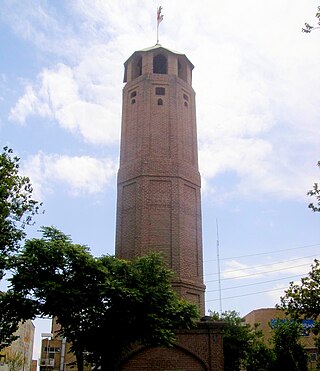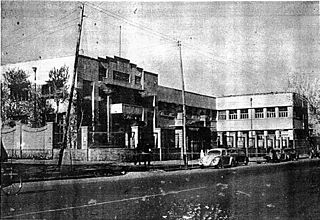Related Research Articles

El Goli, also called Shah Goli is a large historic park in the south east region of Tabriz, Iran. One of its main features is its large artificial lake, measuring approximately 55.000 m2/592.015 ft square.

Azerbaijan Museum is the major archaeological and historical museum in Tabriz, in the northwest part of Iran. It was established in April 1958. The museum consists of three major halls, a side yard, office rooms and a library. It mostly contains objects discovered from excavations in Iranian Azerbaijan, also some artworks and sculptures of artists. Its library contains more than 2500 books, both handwritten and printed, about history, archaeology, art and Iranian culture.

This is a list of the extreme points of Azerbaijan, the points that are farther north, south, east or west than any other location.

Maqbarat-o-shoara or the Mausoleum of Poets is a Maqbara (graveyard) belonging to classical and contemporary poets, mystics and other notable people, located in the Surkhab district of Tabriz in Iran.

The Amir Nezām House, or The Qajar Museum of Tabriz, is a building in the Sheshghelan district, Tabriz, Iran. This monument which since 2006 houses a museum dedicated to the Qajar dynasty (1781-1925), was built in the period of the Crown Prince Abbas Mirza (1789-1833). Because of persistent neglect over a long period of time, this building had come to be in such a bad state of disrepair that for a time it was seriously considered to demolish it and build a school in its place. Between 1993 and 2006 it has been subject of a renovation process and has been granted the National Heritage status.

The Tabriz Firefighting Tower is a historical tower located in Tabriz, Iran. The tower, standing at 23 meters high, was built in 1917. It was used to investigate fire related incidents inside the city. The city was constantly observed from this tower for any signs of smoke and fire. Following any visual evidence, the firemen were informed and sent to the fire incident location.
Böyürbinə is a village in the Kalbajar District of Azerbaijan.

The Constitution House of Tabriz, also known as Khaneh Mashrouteh, is a historical edifice located next to the Great Bazaar of Tabriz, on Motahari Ave in Tabriz, Iran. During the years which led to Constitutional Revolution and afterwards the house was used as a gathering place of the leaders, activists and sympathizers of the movement. Among them, the most famous people were Sattar khan, Bagher Khan, Seqat-ol-Eslam Tabrizi and Haji Mirza Aqa Farshi and the founder Haji Mehdi Kuzeh kanaani, himself a revolutionary activist and a well-reputed person of the time; who was named Abolmele, i.e. the father of the nation at the time. The two-story building was constructed in 1868 by Haj Vali Me'mar-e TabriziTABRIZ[usurped].

Sheshghelan is one of the districts of Tabriz. Located at the city center, it is one of the oldest quarters of the city and contains several historical buildings, including Qari Bridge, Amir Nezam House, Seyed Hamzeh shrine. Museum of Ostad Bohtouni and Maqbaratoshoara are other points of interest in Sheshgelan.

The Quri River or Quru Chay or Quri Chay is a river in East Azerbaijan province of Iran, in the endorheic basin of Lake Urmia. It originates in the mountains south of Tabriz and joins the Aji Chay just northeast of central Tabriz. Divided by the Quri, the northern and southern parts of Tabriz are connected by several bridges.
Pol Sangi is a bridge in Tabriz, Iran, over the Quri River. The stone bridge belongs to the Qajar period and is located in Chaiknar, in front of the Pol Sangi Mosque. The bridge was registered as a national monument of Iran on August 1, 2005 with the registration number 12438.
Bāghmisheh or Bāghmasha is one of the historic districts of Tabriz, Iran, located in the north-eastern part of the city.
Azerbaijan Square is the largest square in Tabriz. The square is in the vicinity of Tabriz International Airport.

The East-Azerbaijan Provincial Palace is the main office for Iran's East-Azerbaijan provincial governor in downtown Tabriz. The history of the palace goes back to the Safavid and Zand dynasties, when it was named Aali Qapou. The original construction of the palace was supervised by Najaf Qoli Khan for the Safavid kings, when Tabriz was the capital of Iran. During the Qajar era, Aali Qapu served as the residence for the crown prince of Iran. It was reconstructed and repaired under Naser al-Din Shah, when its name was changed to Shams ol-Emareh. Since the Iranian Constitutional Revolution, the palace has been used as the provincial governorship office.
Maralan is a historic district in the southeastern part of Tabriz, the biggest city in Iranian Azerbaijan. To the north lies the Khiyavan district, and to the west, Maralan shares an order with the Nobar district. The Azadi Blvd. divides Maralan district into a northern and southern part.
Davachi is an old and historical district in North of Tabriz. Davachi district is limited to Eynali mountain and Sırxab district in North and east, Meydan Chayi in South and Amirkhiz district in west. Davachi used to have several caravansary, old houses and traditional baths, many of which have been destroyed.
Khatib is a historic and ancient district of Tabriz, Iran. The founding of this district is attributed to Khatib Tabrizi.

Mansur High school or Taleqani High School (in South Azerbaijani: منصور مدرسهسی, in Persian: (دبیرستان منصور is a high school located in city center of Tabriz. A reconstruction of the main building started in 2012.
Tabriz Cycling Track is a 250 m long concrete track in Tabriz, in Iran's East Azerbaijan province. The cycling track is next to the Sahand Stadium and is part of Tabriz Olympic village project. It was officially opened in February 2011.
Khiyavan is one of the oldest districts of Tabriz. Khiyavan is restricted to Meydan River, Maralan district and Azadi Blvd. During the constitutional revolution of Iran, Khiyavan was under the command of Baqir Khan and had an important role in the victory of the revolution.
